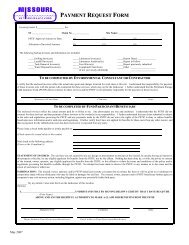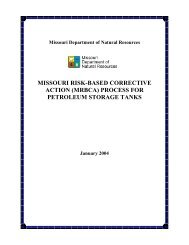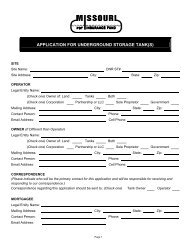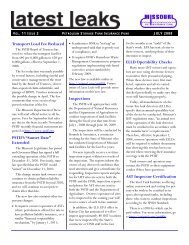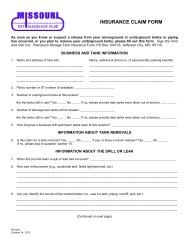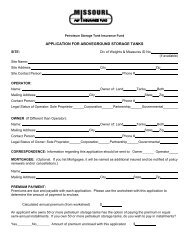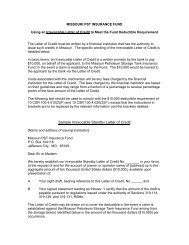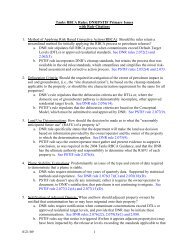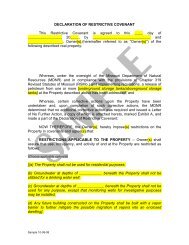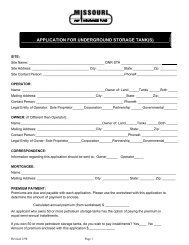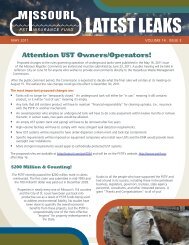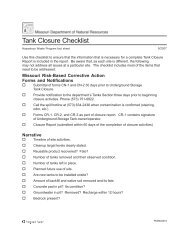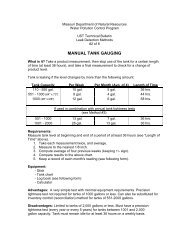Missouri Petroleum Storage Tank Insurance Fund Review of ...
Missouri Petroleum Storage Tank Insurance Fund Review of ...
Missouri Petroleum Storage Tank Insurance Fund Review of ...
You also want an ePaper? Increase the reach of your titles
YUMPU automatically turns print PDFs into web optimized ePapers that Google loves.
TABLE OF CONTENTSLOSS PROJECTIONS FOR MISSOURI PETROLEUM STORAGE TANKINSURANCE FUNDExecutive Summary Section 1Purpose <strong>of</strong> Report Section 2Limitations Section 3Definitions Section 4Background Information Section 5Impact <strong>of</strong> “Risk Based Guidance” Section 6Actuarial Methods Section 7Issues Specific to the RFP Section 8Simulations Section 9ExhibitsSUMMARY OF LOSS RESERVESAT JUNE 30, 2007FISCAL YEAR PROJECTIONSWITH STATUTORY RUNOFFWITH CURRENT PROVISIONS EXTENDEDEXHIBIT IEXHIBIT II.AEXHIBIT II.BLOSS DEVELOPMENTINSURANCE AST- REASON: ALLEXHIBIT III.AINSURANCE UST- REASON: CLOSURE EXHIBIT III.BREMEDIAL AST- REASON: ALL EXHIBIT III.CINSURANCE UST- REASON: RELEASE EXHIBIT III.DREMEDIAL UST - REASON: ALL EXHIBIT III.EINSURANCE UST - REASON: SALE/OTHER EXHIBIT III.FPROJECTED PAID LOSS CASH FLOWSWITH STATUTORY RUNOFFWITH REDUCED FUNDINGSIMULATIONSWITH STATUTORY RUNOFFWITH REDUCED FUNDINGINPUT DISTRIBUTIONSLARGE LOSS ANALYSISEXHIBIT IV.AEXHIBIT IV.BEXHIBIT V.AEXHIBIT V.BEXHIBIT VIKERPER AND BOWRON LLC
<strong>Missouri</strong> <strong>Petroleum</strong> <strong>Storage</strong> <strong>Tank</strong> <strong>Insurance</strong> <strong>Fund</strong><strong>Review</strong> <strong>of</strong> Liabilities and Loss ProjectionsPerformed by: Kerper and Bowron LLC1. Executive SummaryThis report makes an actuarial estimate <strong>of</strong> liabilities at June 30, 2007 <strong>of</strong> 111,175K for the<strong>Missouri</strong> <strong>Petroleum</strong> <strong>Storage</strong> <strong>Tank</strong> <strong>Insurance</strong> <strong>Fund</strong>. Details <strong>of</strong> the operation <strong>of</strong> the fundare noted in Section 4. This would include a 71,266K <strong>of</strong> case reserves and a pointestimate <strong>of</strong> IBNR <strong>of</strong> 39,909K.Projections were also made on a fiscal year cash flow basis from 2008 until 2017.Projections include anticipated revenue from transport load fees and expected expensesand claims payments. Claims payments are projected for both existing claims and newclaims reported in the future. The program sunsets on December 31, 2010, and norevenue is authorized after this date. This cash flow analysis consists <strong>of</strong> 2 separatescenarios:‣ First, it was assumed that the program would sunset and no revenue would beavailable after this date.‣ Second, it was assumed that the program would be reauthorized in its currentform. However, the transport load fee was assumed to drop from $40 to $25 onJanuary 1, 2009.The variance <strong>of</strong> these forecasts in the outlying years was analyzed and found to be large.This is due to the high amount <strong>of</strong> loss development on this program, and uncertainty inthe future years on the frequency, severity and payout pattern <strong>of</strong> the fund. We took theadditional step <strong>of</strong> modeling this uncertainty to construct a range around the possibleoutcomes.Our simulations show that the range <strong>of</strong> possible outcomes increases the further into thefuture we perform projections <strong>of</strong> fund balances.Projection “A” (<strong>Fund</strong> Sunsets on December 31, 2010)• The fund balance on the sunset date is projected to be approximately $105million.• We would expect that the fund would be solvent in 2017.• We expect the fund balance to be depleted sometime after 2017, though there is a25% chance that the fund could be sunsetted without additional funding.• In 2017, there is an 80% chance that the fund balance will be between $12.8million and $39.0 million.
Loss Projections for <strong>Missouri</strong> <strong>Petroleum</strong> <strong>Storage</strong> <strong>Tank</strong> <strong>Insurance</strong> <strong>Fund</strong>Projection “B” (<strong>Fund</strong> Reauthorized at Lower <strong>Fund</strong>ing Level)• The fund balance on the sunset date is projected to be approximately $91 million.• We would expect that the fund would become technically solvent in 2016 (Assets<strong>of</strong> the fund would be greater than the liabilities).• In 2017, there is an 80% chance that the fund balance will be between $68.2million and $107.0 million. We would expect that the surplus in the fund at thisdate to be approximately $3.7 million.2. Purpose <strong>of</strong> StudyThe purpose <strong>of</strong> this study is to review the reserves and loss projections for the <strong>Missouri</strong><strong>Petroleum</strong> <strong>Insurance</strong> <strong>Fund</strong>. The fund’s Board <strong>of</strong> Trustees contracted with Kerper andBowron LLC to perform this storage tank review. Loss projections have been made forthe years 2008 through 2017.Actuarial data and guidance for this study were provided by both the Board’s staff andWilliams and Company (the third-party administrator <strong>of</strong> this program).3. LimitationsActuarial projections rely on extrapolating past trends to make assumptions about futuredevelopment and emergence <strong>of</strong> claims. Since these claims are subject to significantrandom deviations as well as changes in the legal and regulatory climate, it is possiblethat the actual results may differ significantly from the projections that have been made.Consistency - The conclusions are predicated on the assumptions that the selectedreporting, reserving, and payment patterns, frequency and severity trends, and claimdistributions apply, and will continue to apply, to the program. The risk exposurecovered by the program as well as the claim management and settlement practices areassumed to be consistent over time, except as noted.Entire Document - The study conclusions are developed in the accompanying text andexhibits, which together comprise the report.Data Reliance - the PSTIF Board <strong>of</strong> Trustee’s staff and Williams and Company providedthe data for this study. In the study, we relied on the accuracy and completeness <strong>of</strong> thisdata without independent audit. If the data is inaccurate or incomplete, our findings andconclusions may need to be revised.Management Reliance - the PSTIF Board <strong>of</strong> Trustee’s staff and Williams and Companyprovided information concerning the program structure and risk exposure. In the study,we relied on the accuracy and completeness <strong>of</strong> this information without independentverification. If the information is inaccurate or incomplete, our findings and conclusionsmay need to be revised.Kerper and Bowron LLCPage 2
Loss Projections for <strong>Missouri</strong> <strong>Petroleum</strong> <strong>Storage</strong> <strong>Tank</strong> <strong>Insurance</strong> <strong>Fund</strong>Underlying Assumptions - In addition to the assumptions stated in the report, numerousother assumptions underlie the calculations and results presented herein.Study Foundations - The study conclusions were based on analysis <strong>of</strong> the available dataand on the estimation <strong>of</strong> many contingent events. Future costs were developed from thehistorical claim experience and covered exposure, with adjustments for anticipatedchanges.Significant Digits - Numbers in the exhibits are generally shown to more significantdigits than their accuracy suggests. This has been done to simplify review <strong>of</strong> thecalculations.Interpretation <strong>of</strong> Conclusions - Some <strong>of</strong> the assumptions, methods, and conclusions inthis report are <strong>of</strong> a significantly technical nature. The recipient should understand theassumptions, methodology and possible variability in results that are inherent in ourconclusions. We are available to discuss our assumptions, methodology and conclusionsin greater detail.Assets - We have assumed that valid assets, which have appropriate maturities andsufficient liquidity to meet the cash flow requirements <strong>of</strong> the <strong>Missouri</strong> <strong>Petroleum</strong> <strong>Storage</strong><strong>Tank</strong> <strong>Insurance</strong> <strong>Fund</strong>, support the reserves. We make no guarantee that <strong>Missouri</strong><strong>Petroleum</strong> <strong>Storage</strong> <strong>Tank</strong> <strong>Insurance</strong> <strong>Fund</strong> funds will prove sufficient.Uncertainty - Due to the uncertainties inherent in the estimation <strong>of</strong> future costs, it cannotbe guaranteed that the estimates set forth in the report will not prove to be inadequate orexcessive and actual costs may vary significantly from our estimates.Unanticipated Changes - Unanticipated changes in factors such as judicial decisions,legislative actions, claim consciousness, claim management, claim settlement practices,and economic conditions may significantly alter the conclusions.Best Estimate - These caveats and limitations notwithstanding, the conclusions representour best estimate <strong>of</strong> the actuarial status and funding requirements <strong>of</strong> the program as <strong>of</strong> thedate <strong>of</strong> this report.4. Terms used in StudyIBNR. IBNR stands for claims Incurred But Not Reported. This is the estimatedadditional amount needed to close all claims currently reported to the fund.Loss. The use <strong>of</strong> the term loss without modification includes loss and legal costs butdoes not include unallocated loss adjustment expense (ULAE).Kerper and Bowron LLCPage 3
Loss Projections for <strong>Missouri</strong> <strong>Petroleum</strong> <strong>Storage</strong> <strong>Tank</strong> <strong>Insurance</strong> <strong>Fund</strong>ULAE. Unallocated Loss Adjustment Expenses. These are claims settlement expenses.There is no provision in the IBNR for claims settlement provisions. However, the cashflow projections include a provision for these.Case Reserves. These are loss reserves set for individual claims by the adjuster.Indicated Loss Reserve. This is IBNR + Case Reserves. This is the estimated totalamount to close all claims at June 30, 2007.Cash Flow Projection. This is the projected increase or decrease in cash flow during acalendar year. It is the difference between the projected revenue and the projected lossesand expenses.5. Background Information (This has been provided by the <strong>Missouri</strong><strong>Petroleum</strong> <strong>Tank</strong> <strong>Insurance</strong> <strong>Fund</strong>)The <strong>Petroleum</strong> <strong>Storage</strong> <strong>Tank</strong> <strong>Insurance</strong> <strong>Fund</strong> was established by the <strong>Missouri</strong> Legislaturein 1989, (at the time, it was called the “Underground <strong>Storage</strong> <strong>Tank</strong> <strong>Insurance</strong> <strong>Fund</strong>”). Itwas originally housed in the Office <strong>of</strong> Administration. In 1991, the <strong>Missouri</strong> GeneralAssembly substantially amended the law governing the <strong>Petroleum</strong> <strong>Storage</strong> <strong>Tank</strong><strong>Insurance</strong> <strong>Fund</strong>. A new revenue mechanism - the “transport load fee” - was established,and responsibility for managing and operating the <strong>Petroleum</strong> <strong>Storage</strong> <strong>Tank</strong> <strong>Insurance</strong><strong>Fund</strong> was transferred to the Department <strong>of</strong> Natural Resources. <strong>Petroleum</strong> distributors,licensed by the Department <strong>of</strong> Revenue, paid the transport load fee. It was a “selfreportedfee” paid monthly by these distributors and collected by the Department <strong>of</strong>Revenue for deposit into the <strong>Petroleum</strong> <strong>Storage</strong> <strong>Tank</strong> <strong>Insurance</strong> <strong>Fund</strong>. Collection <strong>of</strong> thefee began on October 1, 1991.In 1992, after receiving a report and recommendations from Milliman & Robertson, Inc.,the Department <strong>of</strong> Natural Resources engaged an outside contractor to provide third-partyadministration services (currently Williams and Company) and began operation <strong>of</strong> the<strong>Petroleum</strong> <strong>Storage</strong> <strong>Tank</strong> <strong>Insurance</strong> <strong>Fund</strong>.In 1992, the <strong>Petroleum</strong> <strong>Storage</strong> <strong>Tank</strong> <strong>Insurance</strong> <strong>Fund</strong> had a single purpose: to insureowners and operators <strong>of</strong> underground storage tanks which contained petroleum for risksassociated with cleanup <strong>of</strong> spills and leaks, and third-party damages which might resultfrom such spills or leaks.The first insurance policies were issued by the Department <strong>of</strong> Natural Resources thirdpartyadministrator in May 1992. “Participation fees” were collected and deposited intothe <strong>Petroleum</strong> <strong>Storage</strong> <strong>Tank</strong> <strong>Insurance</strong> <strong>Fund</strong> by the third party administrator.The first claims were filed later in 1992, and the first claim payment was made in June1993.Kerper and Bowron LLCPage 4
Loss Projections for <strong>Missouri</strong> <strong>Petroleum</strong> <strong>Storage</strong> <strong>Tank</strong> <strong>Insurance</strong> <strong>Fund</strong>In 1993, the <strong>Petroleum</strong> <strong>Storage</strong> <strong>Tank</strong> <strong>Insurance</strong> <strong>Fund</strong> cash balance passed $20 million,triggering cessation <strong>of</strong> collection <strong>of</strong> the transport load fee on September 30, 1993.In 1995, the Legislature expanded the purposes <strong>of</strong> the <strong>Petroleum</strong> <strong>Storage</strong> <strong>Tank</strong> <strong>Insurance</strong><strong>Fund</strong> by enacting legislation which authorized the <strong>Petroleum</strong> <strong>Storage</strong> <strong>Tank</strong> <strong>Insurance</strong><strong>Fund</strong> to pay, in certain circumstances, the costs <strong>of</strong> cleaning up contamination which hadoccurred when underground tanks containing petroleum leaked in past years. Thislegislation was called House Bill 251 (HB251). In particular, this bill authorizedpayment <strong>of</strong> cleanup costs for properties where:• Underground storage tanks containing petroleum had been operated in the past,but were taken out <strong>of</strong> use before August 28, 1995; and• The existence <strong>of</strong> such property was reported to or documented by the Department<strong>of</strong> Natural Resources by August 28, 1995; or• A leak or spill had occurred in the past from an underground storage tank; and• The owner or operator <strong>of</strong> that tank - if it was still in use - applied for an insurancepolicy from <strong>Petroleum</strong> <strong>Storage</strong> <strong>Tank</strong> <strong>Insurance</strong> <strong>Fund</strong> by August 28, 1995, and wasultimately insured.This legislation triggered the receipt, in August 1995, <strong>of</strong> over 700 additional applicationsfor insurance coverage on sites where there were underground storage tanks in use. Inaddition, it triggered thousands <strong>of</strong> communications to the Department <strong>of</strong> NaturalResources about tank sites, some <strong>of</strong> which were already known to the Department <strong>of</strong>Natural Resources.Overnight, the known liabilities <strong>of</strong> the <strong>Petroleum</strong> <strong>Storage</strong> <strong>Tank</strong> <strong>Insurance</strong> <strong>Fund</strong> grewfrom liability for about 300 claims made by insured storage tank sites to liability forabout 1,100 claims, most <strong>of</strong> which were for old releases that occurred before the<strong>Petroleum</strong> <strong>Storage</strong> <strong>Tank</strong> <strong>Insurance</strong> <strong>Fund</strong> was established. In addition, the <strong>Petroleum</strong><strong>Storage</strong> <strong>Tank</strong> <strong>Insurance</strong> <strong>Fund</strong> became liable for future claims at an unknown number <strong>of</strong>“out-<strong>of</strong>-use tank sites” which were “known” to the Department <strong>of</strong> Natural Resources byAugust 28, 1995. Because <strong>of</strong> the increased liabilities, collection <strong>of</strong> the transport load feebegan again on April 1, 1996 and has continued uninterrupted since. The transport loadfee was increased from $25 to $40 per 8,000-gallon transport load <strong>of</strong> petroleum onJanuary 1, 2002.In 1996, the state legislature again amended the law, and “reopened the window <strong>of</strong>opportunity” for persons to obtain <strong>Petroleum</strong> <strong>Storage</strong> <strong>Tank</strong> <strong>Insurance</strong> <strong>Fund</strong> benefits. TheAugust 28, 1995 deadline established by HB251 was extended to December 31, 1997.Again, owners/operators <strong>of</strong> tank sites with known, pre-existing leaks or spills, who werestill doing a cleanup, who applied for insurance coverage from <strong>Petroleum</strong> <strong>Storage</strong> <strong>Tank</strong><strong>Insurance</strong> <strong>Fund</strong> and were ultimately insured, could get benefits for their ongoing costs <strong>of</strong>cleanup. Also, owners <strong>of</strong> properties with “out-<strong>of</strong>-use tanks” could report those propertiesKerper and Bowron LLCPage 5
Loss Projections for <strong>Missouri</strong> <strong>Petroleum</strong> <strong>Storage</strong> <strong>Tank</strong> <strong>Insurance</strong> <strong>Fund</strong>to the Department <strong>of</strong> Natural Resources and in so doing, make the property eligible toreceive benefits from <strong>Petroleum</strong> <strong>Storage</strong> <strong>Tank</strong> <strong>Insurance</strong> <strong>Fund</strong>, if a cleanup was requiredsome time in the future.The 1996 legislation further expanded the <strong>Petroleum</strong> <strong>Storage</strong> <strong>Tank</strong> <strong>Insurance</strong> <strong>Fund</strong> byextending the same two purposes for certain aboveground storage tanks (ASTs). ASTowners whose tanks were in service could now apply for and receive insurance coverage,and sites where ASTs were out <strong>of</strong> use by December 31, 1997 could receive benefits forcleanup, if the site was reported to the Department <strong>of</strong> Natural Resources by that date.The 1996 legislation, known as Senate Bill 708 (SB708), also established a board <strong>of</strong>trustees to manage the <strong>Petroleum</strong> <strong>Storage</strong> <strong>Tank</strong> <strong>Insurance</strong> <strong>Fund</strong>, effectively movingadministration and responsibilities from the Department <strong>of</strong> Natural Resources to theboard <strong>of</strong> trustees. The board <strong>of</strong> trustees took over management <strong>of</strong> the third partyadministrator contract, employed an Executive Director, and has managed the <strong>Petroleum</strong><strong>Storage</strong> <strong>Tank</strong> <strong>Insurance</strong> <strong>Fund</strong> since.Prior actuarial studies on this book include:‣ A review <strong>of</strong> the <strong>Petroleum</strong> <strong>Storage</strong> <strong>Tank</strong> <strong>Insurance</strong> <strong>Fund</strong> operations and anactuarial study was performed by Milliman & Robertson in 1996.‣ An actuarial study performed by Matthews Actuarial LLC in 2003.‣ An actuarial study performed by Pinnacle Actuarial in 2005.In 2001, the state legislature again amended the law, extending the “sunset date” <strong>of</strong> theprogram to December 31, 2010. The legislation (HB453) also gave the <strong>Petroleum</strong><strong>Storage</strong> <strong>Tank</strong> <strong>Insurance</strong> <strong>Fund</strong> board <strong>of</strong> trustees the authority to raise the transport load feeto a maximum <strong>of</strong> $60.00, with no annual increase in excess <strong>of</strong> $15.00.Today, the <strong>Petroleum</strong> <strong>Storage</strong> <strong>Tank</strong> <strong>Insurance</strong> <strong>Fund</strong> insures 7,395 underground storagetanks at 2,663 sites. It also insures 2,109 aboveground storage tanks at 515 sites.Claims filed by persons who are or were insured at the time the contamination wasdiscovered are called “insurance claims”. Many <strong>of</strong> the insurance claims involve cleanup<strong>of</strong> historical contamination released into the environment during a lengthy period <strong>of</strong>operation <strong>of</strong> the storage tanks, including operation prior to implementation <strong>of</strong> today’senvironmental standards.The insurance protection provided by the <strong>Petroleum</strong> <strong>Storage</strong> <strong>Tank</strong> <strong>Insurance</strong> <strong>Fund</strong> toactive tank owners includes coverage for up to $1 million per occurrence, $2 millionannual aggregate, for costs <strong>of</strong> cleanup, third-party property damage, and third-partybodily injury. There is a deductible <strong>of</strong> $10,000 per occurrence.Claims filed to clean up a “pre-existing” leak/spill at an insured site, or an “out-<strong>of</strong>-use”tank site, are called “remedial claims.”Kerper and Bowron LLCPage 6
Loss Projections for <strong>Missouri</strong> <strong>Petroleum</strong> <strong>Storage</strong> <strong>Tank</strong> <strong>Insurance</strong> <strong>Fund</strong>For “remedial claims,” the <strong>Petroleum</strong> <strong>Storage</strong> <strong>Tank</strong> <strong>Insurance</strong> <strong>Fund</strong> pays up to $1 millionfor cleanup costs per site; there is no coverage for third-party property damage or thirdpartybodily injury. The person doing the cleanup must pay the first $10,000 <strong>of</strong> cleanupcosts.A claim reserve is established for each instance where a release is confirmed and the siteis eligible to receive benefits from the <strong>Petroleum</strong> <strong>Storage</strong> <strong>Tank</strong> <strong>Insurance</strong> <strong>Fund</strong>. Theclaim reserves are adjusted on an ongoing basis as more information about the site, theextent <strong>of</strong> contamination, and the planned cleanup is available. No claim reserve forfuture claims is currently maintained.A balance sheet and income statement are prepared monthly, using information providedby the State Accounting System and data maintained by the <strong>Petroleum</strong> <strong>Storage</strong> <strong>Tank</strong><strong>Insurance</strong> <strong>Fund</strong> board <strong>of</strong> trustees’ third party administrator under the provisions <strong>of</strong> itscontract.In 1998, the Legislature significantly changed the way various fees and taxes onpetroleum are collected. As part <strong>of</strong> House Bill 619, the point <strong>of</strong> payment <strong>of</strong> the<strong>Petroleum</strong> <strong>Storage</strong> <strong>Tank</strong> <strong>Insurance</strong> <strong>Fund</strong> transport load fee was transferred from thepetroleum distributor to the petroleum supplier, resulting in fewer payers.All claim files <strong>of</strong> the <strong>Petroleum</strong> <strong>Storage</strong> <strong>Tank</strong> <strong>Insurance</strong> <strong>Fund</strong> are maintained at <strong>of</strong>ficeslocated in Jefferson City, MO.The board <strong>of</strong> trustees’ third-party administrator provides services in the following fourareas:‣ Underwriting, including the receipt and review <strong>of</strong> initial insurance applicationsand annual insurance renewal applications. This process includes a compliancereview <strong>of</strong> the facility’s operating records, including review <strong>of</strong> leak detectionrecords, maintenance documents, logs <strong>of</strong> cathodic protection system readings, etc.‣ Inspections, including physical review <strong>of</strong> a minimum <strong>of</strong> 10% <strong>of</strong> the propertiesinsured by the <strong>Petroleum</strong> <strong>Storage</strong> <strong>Tank</strong> <strong>Insurance</strong> <strong>Fund</strong> annually.‣ Claims management, including the receipt <strong>of</strong> notices <strong>of</strong> claims, claimsinvestigation and adjusting services, eligibility determinations, receipt and review<strong>of</strong> cost estimates from owners and/or their consultants for characterizing andcleaning up contamination, review <strong>of</strong> invoices, and preparation <strong>of</strong> paymentrecommendations.‣ Record-keeping and other administrative services, including design andmaintenance <strong>of</strong> s<strong>of</strong>tware for maintaining <strong>of</strong>ficial records <strong>of</strong> the <strong>Petroleum</strong> <strong>Storage</strong><strong>Tank</strong> <strong>Insurance</strong> <strong>Fund</strong>, maintenance <strong>of</strong> the <strong>Petroleum</strong> <strong>Storage</strong> <strong>Tank</strong> <strong>Insurance</strong><strong>Fund</strong> web site, receipt <strong>of</strong> and response to public inquiries, technical assistance toKerper and Bowron LLCPage 7
Loss Projections for <strong>Missouri</strong> <strong>Petroleum</strong> <strong>Storage</strong> <strong>Tank</strong> <strong>Insurance</strong> <strong>Fund</strong>tank owners, and other support services for the Executive Director and the board<strong>of</strong> trustees.The Attorney General's Office (AGO) annually receives approval from the board <strong>of</strong>trustees for an appropriation from the <strong>Petroleum</strong> <strong>Storage</strong> <strong>Tank</strong> <strong>Insurance</strong> <strong>Fund</strong> to supportone-half an FTE. This person provides legal advice and counsel to the board <strong>of</strong> trusteesand the Executive Director.The board <strong>of</strong> trustees has also engaged outside counsel to defend insured tankowners/operators when a third-party claimant files litigation against the tankowner/operator.The Department <strong>of</strong> Revenue annually receives approval from the board <strong>of</strong> trustees for anappropriation from the <strong>Petroleum</strong> <strong>Storage</strong> <strong>Tank</strong> <strong>Insurance</strong> <strong>Fund</strong> to pay for its servicescollecting the transport load fee.The Department <strong>of</strong> Natural Resources annually receives approval from the board <strong>of</strong>trustees for an appropriation from the <strong>Petroleum</strong> <strong>Storage</strong> <strong>Tank</strong> <strong>Insurance</strong> <strong>Fund</strong> to supportits regulatory activities. This is an ongoing administrative expense.In May 2002, the PSTIF began <strong>of</strong>fering an extended reporting period to ASTowners/operators who sold their tanks or took them out <strong>of</strong> service. In May 2004, thePSTIF began <strong>of</strong>fering this same option to underground storage tank owners. Owners maypurchase the extended reporting period annually for a period <strong>of</strong> up to five (5) years aftertheir tanks are sold or closed. Of the 913 PSTIF participants to whom this <strong>of</strong>fer has beenmade, 449 purchased the extended reporting period for at least one (1) year. Currentlythere are 319 such endorsements in effect.Experience indicates that the majority <strong>of</strong> covered leaks relate to fittings and joints onpipes. It is less frequent that situated tanks themselves experience failure. In someinstances coverage has been expanded for leaks at a gas pump, even when there is nodamage to the tank or fittings.Today, the <strong>Petroleum</strong> <strong>Storage</strong> <strong>Tank</strong> <strong>Insurance</strong> <strong>Fund</strong> insures 7,395 underground storagetanks at 2,663 sites. It also insures 2,109 aboveground storage tanks at 515 sites.6. Impact <strong>of</strong> “Risk Based Guidance” on Actuarial ResultsThe Department <strong>of</strong> Natural Resources issued risk-based guidance standards in February2004. These standards replace the previous standards under which claims were settledand “no further action” letters issued. The purpose <strong>of</strong> the standards was to replace a rigidsystem <strong>of</strong> environmental standards to a more flexible system which reflected the risk thatspecific contaminants posed for a given site.Kerper and Bowron LLCPage 8
Loss Projections for <strong>Missouri</strong> <strong>Petroleum</strong> <strong>Storage</strong> <strong>Tank</strong> <strong>Insurance</strong> <strong>Fund</strong>At the time the standards were implemented, about 1,500 claims were in the process <strong>of</strong>settlement. Some <strong>of</strong> these claims were settled under the old standard but the majoritywere settled under the new “risk based” standard.While it is difficult to say what the impact <strong>of</strong> the new standards will be, it might beexpected that claim settlement costs could be lower under the new standards sinceenvironmentally unnecessary work will not be necessary. Also, there is some concernthat claim settlement rates might decrease as claims remain open for longer periods asanalysis is taken to determine the amount <strong>of</strong> remediation necessary for the site.Even though the risk-based guidance has now been in effect for 3 1/2 years, it is stilldifficult to accurately gauge the impact <strong>of</strong> the standards on the overall costs <strong>of</strong> thesystem. There is little evidence that reserve adequacy or claim closure rates havechanged dramatically under the new system. However credibility issues prevent anaccurate measurement <strong>of</strong> the new standards.Data7. Actuarial MethodologyLoss data was developed from a transactional pull from Williams and Company claimssystems. Loss data was from inception until June 30, 2007. Data was analyzed on afiscal year basis. Revenue was generated from reports provided by the MPSTIF. Theseexhibits showed the transport fees, initial tank fees, and policy premiums.During the analysis <strong>of</strong> data, data was segregated into the type <strong>of</strong> policy(<strong>Insurance</strong>/Remedial) and the type tank (AST/UST). In addition, it was discovered thatdevelopment patterns for insured UST tanks differed by the cause <strong>of</strong> loss. For thepurposes <strong>of</strong> this report UST <strong>Insurance</strong> claims were divided into 3 separate subcategories:Closure, Release, and Sale/Other. Claims which were the result <strong>of</strong> a “Sale” appear todevelop much slower than other types <strong>of</strong> claims.Claim type was not credible for AST claims, and it not available for any remedial claims.Therefore, there are no breakouts for these types <strong>of</strong> claims.Summarizing the above classifications, data was analyzed for the following 6 categories:1. <strong>Insurance</strong> UST claims – Closure2. <strong>Insurance</strong> UST claims – Sale/Other3. <strong>Insurance</strong> UST claims – Release4. <strong>Insurance</strong> AST claims5. Remedial UST claims6. Remedial AST claimsThe data was organized on a “report year” or “claims made” basis. The reason for this isthat there is not usually credible data on when a leak takes place.Kerper and Bowron LLCPage 9
Loss Projections for <strong>Missouri</strong> <strong>Petroleum</strong> <strong>Storage</strong> <strong>Tank</strong> <strong>Insurance</strong> <strong>Fund</strong>Projection MethodsEach <strong>of</strong> these categories was analyzed for past patterns <strong>of</strong> loss development. Because <strong>of</strong>the volatility <strong>of</strong> these claims, loss development was <strong>of</strong>ten not consistent. Lossdevelopment was not credible for the later periods, and significant judgment was utilizedin selecting loss development for later periods, especially for paid losses.These losses are developed in Exhibit III. All 6 categories utilized the first two methods,while only the insurance claims were appropriate for the Bornhuetter-Ferguson method.“Reported Loss Development” – Paid losses and case reserves (reported losses) aregrouped by age and projected to ultimate“Paid Loss Development” – Paid losses are grouped by age and projected to ultimate“Reported Bornhuetter-Ferguson Method” - This method applies reported lossdevelopment to the “expected losses” for a given year.In this case, expected losses were derived from the participation fees for UST and ASTinsurance. In these cases, the ratio <strong>of</strong> claims to the fees will not be meaningful except inestablishing a baseline ratio for expected claims.“Paid Bornhuetter-Ferguson Method” - This method applies paid loss development tothe “expected losses” for a given year.“Frequency/Severity Method”– This method combines ultimate frequency and severitytogether. This method was used to project report year losses from 2008 – 2017. It doesnot yield different results than the reported method since there is no development onclaims.Ultimate losses were judgmentally selected from an average <strong>of</strong> these methods. Ingeneral, paid loss methods were not weighted heavily for the most recent years due to theinstability <strong>of</strong> this method with recent data.In general, there appeared to be very little development on reported losses after 5 years.Paid losses, however, appear to continue to develop even on years prior to the year 2000.This typically results in the paid loss estimate being higher than the reported lossestimate.Current Case ReservingConsistent case reserving is critical for actuarial projections.‣ Due to the lowering <strong>of</strong> development factors in recent years, it appears that casereserving is much more accurate for recent years.Kerper and Bowron LLCPage 10
Loss Projections for <strong>Missouri</strong> <strong>Petroleum</strong> <strong>Storage</strong> <strong>Tank</strong> <strong>Insurance</strong> <strong>Fund</strong>‣ Case reserves at the end <strong>of</strong> a fiscal year are estimated to be 42% and 72% <strong>of</strong>ultimate settlement levels depending on the type <strong>of</strong> claim.‣ Development on case reserves would be considered normal or low by industrystandards.‣ Claim severities, while volatile given the nature <strong>of</strong> the data, appear to be stableover time. Therefore, there does not appear to be any reason to change baselinereserving practices.‣ It is not recommended that any major changes occur to case reservingmethodology unless external circumstances dictate. This is due to the adequacy<strong>of</strong> current reserving, as well as the impact that reserving changes would have onfuture actuarial analysis.Projected Ultimate Liabilities as <strong>of</strong> June 30, 2007As noted above, this report makes an actuarial estimate <strong>of</strong> liabilities at June 30, 2007 <strong>of</strong>111,175K for the <strong>Fund</strong>. This includes 71,266K <strong>of</strong> case reserves and 39,909K <strong>of</strong> IBNR.Projected Fiscal Year ResultsBalance sheet and income statements were projected for two scenarios through 2017. Itwas decided to only project losses through 2017 since projections beyond this date arehighly subjective.First, the projections assumed that the fund would sunset as <strong>of</strong> December 31, 2010. Allprojections for fiscal year 2011 are estimated at 50% <strong>of</strong> the level <strong>of</strong> the fully fundedlevel. No new claims would be accepted after this date. Second, the projection assumedthat the current funding level would continue through 2017. In addition, the fund wouldcontinue to accept claims in the same manner that it does today.In general, the Williams and Company projections were used as a basis for theseprojections for the revenue and expense items. However some minor changes were madeto the Williams and Company numbers. These changes include:• Expenses after the sunset date are estimated at the ratio <strong>of</strong> the paid claims fromthe sunset scenario to the fully funded scenario. In this way, it would be assumedthat the expenses <strong>of</strong> the fund would reflect the amount <strong>of</strong> payments from the fund.• Interest income is calculated on the average <strong>of</strong> the prior and current year-end fundbalances• The interest income was selected at 4% due to recent investment experience.,Losses were derived from the ultimate loss selections as well as the frequency andseverity <strong>of</strong> new claims in the years 2008 through 2017. These claims are paid outaccording to the selected payout pattern that is based on historical data.Kerper and Bowron LLCPage 11
Loss Projections for <strong>Missouri</strong> <strong>Petroleum</strong> <strong>Storage</strong> <strong>Tank</strong> <strong>Insurance</strong> <strong>Fund</strong>8. Issues specific to this RFPReinsuranceA brief evaluation <strong>of</strong> reinsurance has been requested as part <strong>of</strong> this RFP.Reinsurance has many functions. Some <strong>of</strong> them in main functions <strong>of</strong> reinsurance are:‣ Risk transfer -- reinsurance is a tool to transfer large risks from the insureror fund to the reinsurer.‣ Income smoothing -- Reinsurance can be used to absorb large losses andnormalize income for the fund.‣ Surplus relief -- For insurance companies without adequate capital,reinsurance is <strong>of</strong>ten used as a tool to underwrite more risk than theircapital structure would permit.‣ Arbitrage -- If the rates for the reinsurer are below the rates available inthe market, then an insurance company or fund might choose to reinsurethe risks in order to guarantee a certain marginFor the purposes <strong>of</strong> the <strong>Missouri</strong> PSTIF, only risk transfer would be an applicable reasonto purchase reinsurance. Income smoothing and surplus relief are not necessary for agovernmental fund. Arbitrage would likely not exist for this type <strong>of</strong> risk.Reinsurance is typically purchased either directly from the reinsurer or through a network<strong>of</strong> reinsurance brokers. Reinsurance can be underwritten in a wide variety <strong>of</strong> forms. Forexample, a reinsurance contract might indemnify the fund for a claim amount above acertain level, such as $500,000. A reinsurance contract could potentially be structuredsuch that the payments from the fund in a specific layer would be covered, such as annualpayments between $25 million and $50 million might be covered.Preliminary inquiries indicate that reinsurance might be available for this fund; however,additional analysis would need to be undertaken to determine the terms and conditionsthat the market would <strong>of</strong>fer.Large Claims (above $250,000)Information concerning large claims is included in Exhibit VI.While large claims represent a substantial portion <strong>of</strong> the payments from this fund (similarto many insurance ventures), it is difficult to segregate and analyze these claims in ameaningful way.This is because most large claims began as small claims and develop to larger claimsover time. We've included some statistics as to the amount <strong>of</strong> large claims and thehistorical amount <strong>of</strong> large claims by report year. Not surprisingly the percentage <strong>of</strong> largeKerper and Bowron LLCPage 12
Loss Projections for <strong>Missouri</strong> <strong>Petroleum</strong> <strong>Storage</strong> <strong>Tank</strong> <strong>Insurance</strong> <strong>Fund</strong>event, such as an inflationary shock or a judicial decision, but does not exist in ourhistorical database. Therefore the actual ranges <strong>of</strong> results for the fund are likely morevariable than this analysis suggests. Nevertheless this remains a good tool for planning.Description <strong>of</strong> Actuarial ModelThe actuarial model shown in the exhibits included with this report is considered the mostlikely, “average” outcome. Our model calculated fund balances under 3,000 differentclaim payment scenarios, each scenario being equally likely as the prior. The results fromeach individual scenario are not shown, but rather summarized in the simulation graphsand tables in this report.The most uncertain component affecting our projections <strong>of</strong> future MPSTIF fund balancesare our projections <strong>of</strong> ultimate claim payments for each individual report year, and thedollar amount <strong>of</strong> claim payment occurring in each specific calendar year. These are thevalues we simulated. The process <strong>of</strong> using simulations to understand the range <strong>of</strong> likelyoutcomes is called a stochastic analysis.Specifically, the payment in each calendar year between 2008 and 2017 emanating fromreport years 1994 to 2017 were separately simulated for the six types <strong>of</strong> claims in thestudy.Based on the simulated claim payments in each scenario, the year-end fund balances for2008 to 2017 were recorded. We then re-simulated claim payments for our next scenario,and again recorded, the year-end fund balances for 2008 to 2017. This process wasrepeated 3,000 times.Technical Description <strong>of</strong> Simulation DistributionsIn order to simulate the claim payments, a statistical distribution must be chosen in orderto reasonably reflect the range <strong>of</strong> possible results. For the purposes <strong>of</strong> this study, wechose the lognormal distribution as the distribution type for the claim payments.‣ For each simulated payment amount we used a separate gamma distribution withseparate parameters. The gamma distribution is widely accepted as arepresentative distribution <strong>of</strong> financial information.‣ For future frequency <strong>of</strong> claims we used a Poisson distribution.‣ For the future severity <strong>of</strong> claims we used a lognormal distribution.‣ For the investment income rates and trends to severity and frequency, we used atriangular distribution.1. DISCUSSION OF RESULTSWe produced 8 histograms and one distribution summary graph for each projection.Kerper and Bowron LLCPage 14
Loss Projections for <strong>Missouri</strong> <strong>Petroleum</strong> <strong>Storage</strong> <strong>Tank</strong> <strong>Insurance</strong> <strong>Fund</strong>Our simulations show that the range <strong>of</strong> possible outcomes increase the further into thefuture we perform projections <strong>of</strong> fund balances. .Projection “A” – <strong>Fund</strong> Sunsets on December 31, 2010• The fund balance on the sunset date is expected to be about 105 million. In 2017,there is an 80% chance that the fund balance will be between $12.8 million and$39.0 million.• We would expect the fund to remain solvent even with no further funding through2017.• There is a reasonable probability (25%) that the fund could be solvent at sunsetwith no additional state funding.Projection “B” – <strong>Fund</strong> Reauthorized at Lower <strong>Fund</strong>ing Level• We would expect that the fund balance would continue to grow as the rate <strong>of</strong> newclaims is significantly below current funding levels.• We would expect that the assets <strong>of</strong> the fund would become greater than theliabilities in FY 2016.GLOSSARY OF TECHNICAL TERMSHistogram – A histogram is made from several rectangles plotted on the graph. The leftand right position <strong>of</strong> each rectangle represents a range <strong>of</strong> possible results (e.g. a rectanglethat spreads from $10 million to $20 million represents all scenarios that had an outputbetween $10 million and $20 million). The height <strong>of</strong> each rectangle represents thepercentage <strong>of</strong> scenarios with that result. The higher the rectangle, the more likely theresult will occur.Monte Carlo Simulation -- A mathematical simulation <strong>of</strong> future results where unknownvalues are selected randomly based on their probability distribution and correlation.Typically, hundreds, or even thousands <strong>of</strong> simulations are produced through computeranalysis. A pr<strong>of</strong>essional must then compile and analyze the results in order to determinereasonable conclusions. A series <strong>of</strong> Monte Carlo simulations can provide conclusionssuch as "There is a 5% chance that revenues will be less than $500,000", or "If theproduct launch in Denver is successful, there is still a 2% chance that revenues will beless than $500,000."Statistical Distribution -- A mathematical formula indicating the likelihood <strong>of</strong> a randomnumber taking on a specific value.Stochastic Analysis -- A type <strong>of</strong> statistical analysis that relies on the use <strong>of</strong> statisticaldistributions <strong>of</strong> unknown variables rather than "best estimates" <strong>of</strong> those unknownvariables. A stochastic analysis usually relies on Monte Carlo simulations.Kerper and Bowron LLCPage 15
MISSOURI PETROLEUM STORAGE INSURANCE TANK FUNDEX V.BPAGE 1 OF 11120Range <strong>of</strong> <strong>Fund</strong> Balances over Time(Scenario B - Reduction <strong>of</strong> Transport Fee in 2009)10080In Millions60402002008 2009 2010 2011 2012 2013 2014 2015 2016 2017Year+75% Perc, -25% Perc +90% Perc, -10% Perc MeanKERPER AND BOWRON LLC9/24/20079:52 PM



